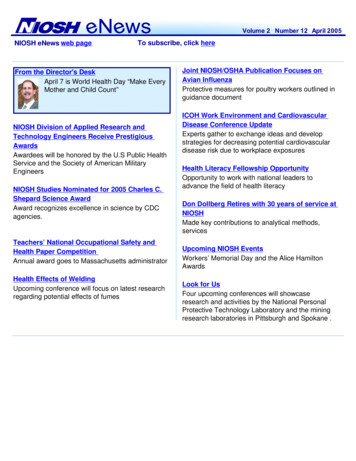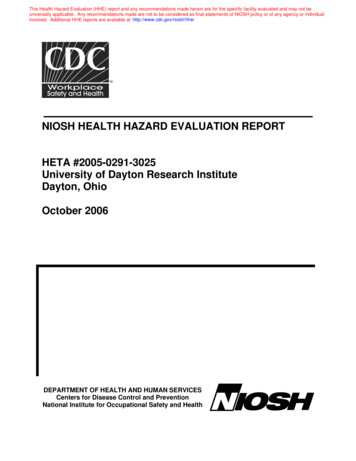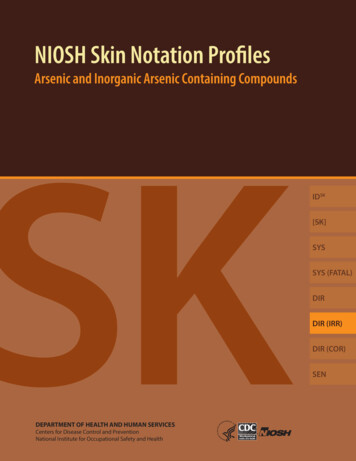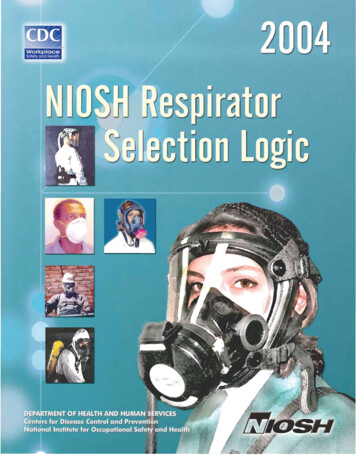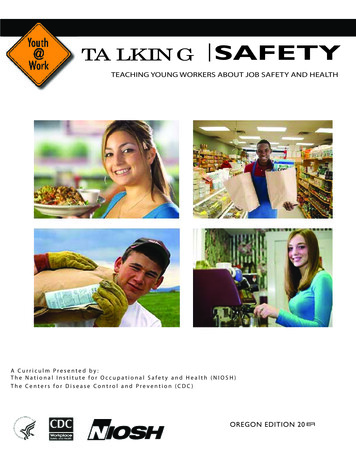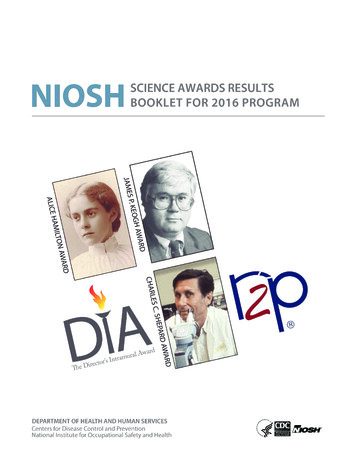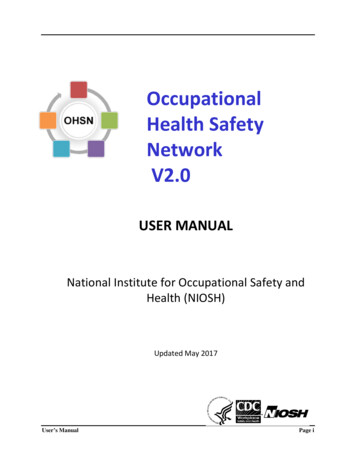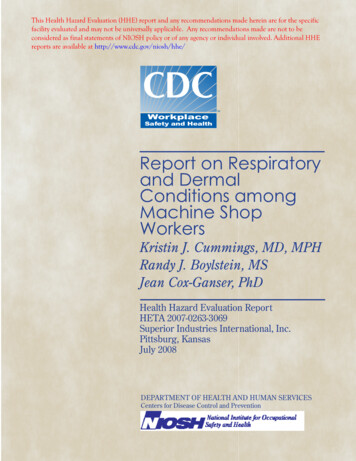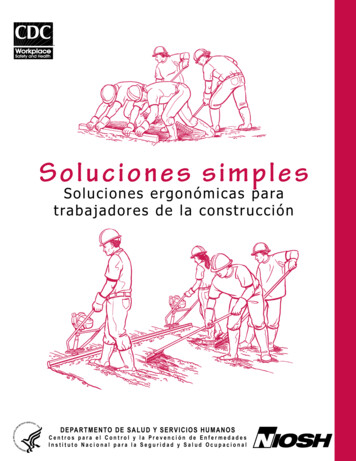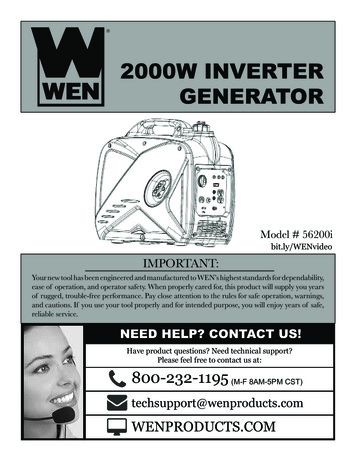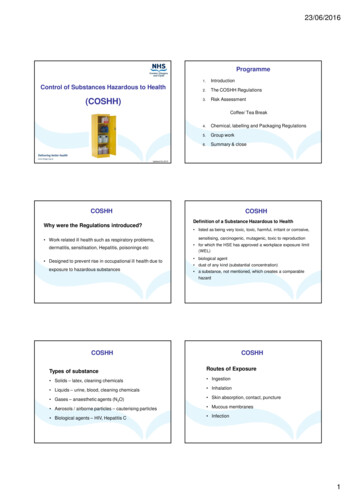
Transcription
ThisThis HealthHealth HazardHazard EvaluationEvaluation (HHE)(HHE) reportreport andand anyany recommendationsrecommendations mademade hereinherein areare forfor thethe specificspecific facilityfacility evaluatedevaluated andand maymay notnot bebe universallyuniversallyapplicable. /www.cdc.gov/niosh/hhe/reportsThis Health Hazard Evaluation (HHE) report and any recommendations made herein are for the specific facility evaluated and may not be universallyapplicable. Any recommendations made are not to be considered as final statements of NIOSH policy or of any agency or individual involved.Additional HHE reports are available at http://www.cdc.gov/niosh/hhe/reportsNIOSH HEALTH HAZARD EVALUATION REPORT:HETA #2001-0144-2867Superior Label SystemsMason, OhioFebruary 2002DEPARTMENT OF HEALTH AND HUMAN SERVICESCenters for Disease Control and PreventionNational Institute for Occupational Safety and Health
PREFACEThe Hazard Evaluations and Technical Assistance Branch (HETAB) of the National Institute forOccupational Safety and Health (NIOSH) conducts field investigations of possible health hazards in theworkplace. These investigations are conducted under the authority of Section 20(a)(6) of the OccupationalSafety and Health (OSHA) Act of 1970, 29 U.S.C. 669(a)(6) which authorizes the Secretary of Health andHuman Services, following a written request from any employer or authorized representative of employees,to determine whether any substance normally found in the place of employment has potentially toxic effectsin such concentrations as used or found.HETAB also provides, upon request, technical and consultative assistance to Federal, State, and localagencies; labor; industry; and other groups or individuals to control occupational health hazards and toprevent related trauma and disease. Mention of company names or products does not constitute endorsementby NIOSH.ACKNOWLEDGMENTS AND AVAILABILITY OF REPORTThis report was prepared by Elena Page, Calvin Cook, Charles Mueller, and Vincent Mortimer of HETAB,Division of Surveillance, Hazard Evaluations and Field Studies (DSHEFS). Ophthalmologic examinationswere performed by Michael Hater, M.D., of the Cincinnati Eye Institute. Field assistance was provided byElaine Moore, Jenise Brassell, Kristen Gwin, Joshua Harney, Gregory Burr, and Bradley King of DSHEFS.Analytical support was provided by Ardith Grote, Division of Applied Research Technology and byDataChem Laboratories. Desktop publishing was performed by Elaine Moore. Review and preparation forprinting were performed by Penny Arthur.Copies of this report have been sent to employee and management representatives at Superior Label Systems,Inc. and the OSHA Regional Office. This report is not copyrighted and may be freely reproduced. Singlecopies of this report will be available for a period of three years from the date of this report. To expedite yourrequest, include a self-addressed mailing label along with your written request to:NIOSH Publications Office4676 Columbia ParkwayCincinnati, Ohio 45226800-356-4674After this time, copies may be purchased from the National Technical Information Service (NTIS) at 5825Port Royal Road, Springfield, Virginia 22161. Information regarding the NTIS stock number may beobtained from the NIOSH Publications Office at the Cincinnati address.For the purpose of informing affected employees, copies of this report shall beposted by the employer in a prominent place accessible to the employees for a periodof 30 calendar days.ii
Highlights of the NIOSH Health Hazard EvaluationEvaluation of Visual Disturbances Related to Amine ExposureNIOSH received a request for a health hazard evaluation (HHE) from Superior Label Systems, Inc. (SLS)in Mason, Ohio, on January 24, 2001. The request stated that employees in the line division of the plant wereexperiencing blurry vision at work, and that one employee had been evaluated by an ophthalmologist whofound a “film over his eyes.”safety hazard, both on the job and whendriving home.What NIOSH Did#We took air samples of 2 amines,dimethylisopropanolamine (DMIPA), anddimethylaminoethanol (DMAE).#We handed out a questionnaire about eyeproblems, work and medical history, andlooked at the ventilation system.#We performed eye examinations on employeesat the beginning and the end of their shift for aweek.#No visual complaints have occurred sincemanagement began to dilute pH adjuster(which contains DMIPA) with water.What Superior Label Systems, Inc.Managers Can Do#Continue to dilute the pH adjuster.#Cover all ink pails to reduce the amount ofchemicals vaporizing into the workenvironment.#Improve local exhaust ventilation at printingpresses.#Do not supply latex rubber gloves. Supply andinstruct workers to wear gloves made ofmaterials that provide better protection.What NIOSH Found#Most employees in the line division reportedblurry vision at work.#The blurry vision made it hard to do their joband/or drive home#Concentrations of DMIPA in the air werehigher in the line division than in the primedivision.#Concentrations of DMAE in the air were higherin the prime division than in the line division.##Exposure to amines at SLS was associated withblurry, halo, and blue-grey vision, clouding ofthe cornea, and decreased vision.Keep all ink pails covered to reduce theamount of chemicals vaporizing into the workenvironment.#Do not wear latex rubber gloves to handlechemicals. Instead, wear gloves made ofmaterials that provide better protection.#The visual problems are reversible, but are aWhat Superior Label Systems, Inc.Employees Can DoWhat To Do For More Information:We encourage you to read the full report. If youwould like a copy, either ask your health andsafety representative to make you a copy or call1-513-841-4252 and ask forHETA Report #2001-0144-0867Highlights of the HHE Reportiii
Health Hazard Evaluation Report 2001-0144-2867Superior Label SystemsMason, OhioOctober 2001Elena H. Page, M.D., M.P.H.Calvin K. Cook, M.S., C.S.P.Charles A. Mueller, M.S.Vincent Mortimer, M.S., P.E.SUMMARYThe National Institute for Occupational Safety and Health (NIOSH) received a request for a health hazardevaluation (HHE) from Superior Label Systems, Inc. (SLS) in Mason, Ohio, on January 24, 2001. Therequest stated that employees in the line division of the plant were experiencing intermittent blurred vision,and that one employee had been evaluated by an ophthalmologist who found a “film over his eyes.”Employees in the prime division of the plant were not experiencing visual disturbances. Workers andmanagement had not been able to associate these visual changes with any particular substance in use.A site visit was conducted on February 8, 2001, that included an opening meeting with management andemployee representatives, an overview of the process, and a walk-through of the plant. Medicalquestionnaires, eye exams, and extensive industrial hygiene monitoring for two types of tertiary aminecompounds, dimethylisopropanolamine (DMIPA) and dimethylaminoethanol (DMAE), were performed fromApril 23-26 and April 30-May 3, 2001.Eighty-nine percent of line workers reported having experienced blurry vision while at work in the past 12months, compared to 12.5% of prime workers (p 0.01). Findings were similar for halo and blue-grey vision.Forty-seven percent of those reporting blurry, halo, or blue-grey vision experienced eye irritation along withthe visual changes, 44% reported difficulty performing their job due to the visual changes, and 39% reporteddifficulty driving home due to vision problems.A total of 108 full-shift personal breathing-zone (PBZ) air samples for the amines were collected, 93 in theline division and 15 in the prime division. The mean time-weighted average (TWA) concentration of DMIPAwas significantly higher in the line division than in the prime division (7.70 mg/m3 vs. 2.08 mg/m3, p 0.01),as was the mean TWA concentration for total amines (9.96 mg/m3 vs. 5.56 mg/m3, p 0.01). The mean TWAconcentration of DMAE was higher in the prime division than the line division (3.47 mg/m3 vs. 2.27 mg/m3,p 0.01).There was a positive association between reported visual symptoms and concentrations of total amines.Higher levels of total amines were associated with increased risk of reporting blurry vision (odds ratio[OR] 1.78, 95% confidence interval [CI] 1.41, 2.26), halo vision (OR 1.38, 95% CI 1.20, 1.58), and bluegrey vision (OR 1.77, 95% CI 1.31, 2.39). All OR reported refer to a per unit increase of 1 mg/m3 in amineconcentration. Symptom reporting increased with exposure to increasing concentrations of amines.The risk of corneal opacity rose with increasing exposure to total amines (OR 1.15, 95% CI 1.02, 1.30).The prevalence of corneal opacity also increased with increasing concentration of total amines. Theiv
prevalence of increased corneal thickness in either eye increased with higher levels of exposure to totalamines, as did both the mean and median changes in thickness. Median corneal thickness increased withincreasing grades of corneal opacity.There was a statistically significant relationship between total amine concentration and increased risk ofreduced bilateral visual acuity and 2.5% contrast sensitivity (OR 1.2, 95% CI 1.001,1.43; OR 1.28, 95%CI 1.14,1.43, respectively).At the time of the site survey, NIOSH investigators notified SLS management that the pH adjuster may beresponsible for workers visual complaints. SLS management promptly began to dilute the pH adjuster,which contains DMIPA, with water. This action resulted in a resolution of visual complaints among theworkers.Exposure to tertiary amines at SLS was found to be associated with visual and ocular changes.While this appears to be a reversible phenomena, these visual changes pose a safety hazard, both onthe job and when driving home. Recommendations include: (1) continuing to dilute the pH adjuster;(2) covering all 5-gallon ink pails to reduce the amount of chemicals vaporizing into the workenvironment; and (3) improving local exhaust ventilation at printing presses.Keywords: SIC Code 2759 (Commercial Printing, Not Elsewhere Classified), blurry vision, halo vision,cornea, amines, tertiary amines, dimethylaminoethanol, dimethylisopropanolamine, DMIPA, DMAE.v
TABLE OF CONTENTSPreface . . . . . . . . . . . . . . . . . . . . . . . . . . . . . . . . . . . . . . . . . . . . . . . . . . . . . . . . . . . . . . . . . . . . . . . . . . . . iiAcknowledgments and Availability of Report . . . . . . . . . . . . . . . . . . . . . . . . . . . . . . . . . . . . . . . . . . . . . . iiHighlights of the HHE Report . . . . . . . . . . . . . . . . . . . . . . . . . . . . . . . . . . . . . . . . . . . . . . . . . . . . . . . . . . iiiSummary . . . . . . . . . . . . . . . . . . . . . . . . . . . . . . . . . . . . . . . . . . . . . . . . . . . . . . . . . . . . . . . . . . . . . . . . . . ivIntroduction . . . . . . . . . . . . . . . . . . . . . . . . . . . . . . . . . . . . . . . . . . . . . . . . . . . . . . . . . . . . . . . . . . . . . . . . 1Background . . . . . . . . . . . . . . . . . . . . . . . . . . . . . . . . . . . . . . . . . . . . . . . . . . . . . . . . . . . . . . . . . . . . . . . .Facility and Process Description . . . . . . . . . . . . . . . . . . . . . . . . . . . . . . . . . . . . . . . . . . . . . . . . . . . . .Ventilation Description . . . . . . . . . . . . . . . . . . . . . . . . . . . . . . . . . . . . . . . . . . . . . . . . . . . . . . . . . . . .Measures of Vision . . . . . . . . . . . . . . . . . . . . . . . . . . . . . . . . . . . . . . . . . . . . . . . . . . . . . . . . . . . . . . .The Cornea . . . . . . . . . . . . . . . . . . . . . . . . . . . . . . . . . . . . . . . . . . . . . . . . . . . . . . . . . . . . . . . . . . . . .Amines . . . . . . . . . . . . . . . . . . . . . . . . . . . . . . . . . . . . . . . . . . . . . . . . . . . . . . . . . . . . . . . . . . . . . . . . .112233Methods . . . . . . . . . . . . . . . . . . . . . . . . . . . . . . . . . . . . . . . . . . . . . . . . . . . . . . . . . . . . . . . . . . . . . . . . . . .Industrial Hygiene Evaluation . . . . . . . . . . . . . . . . . . . . . . . . . . . . . . . . . . . . . . . . . . . . . . . . . . . . . . .Air Sampling . . . . . . . . . . . . . . . . . . . . . . . . . . . . . . . . . . . . . . . . . . . . . . . . . . . . . . . . . . . . . . . . .Ventilation . . . . . . . . . . . . . . . . . . . . . . . . . . . . . . . . . . . . . . . . . . . . . . . . . . . . . . . . . . . . . . . . . . .Medical . . . . . . . . . . . . . . . . . . . . . . . . . . . . . . . . . . . . . . . . . . . . . . . . . . . . . . . . . . . . . . . . . . . . . . . .Statistical Analysis . . . . . . . . . . . . . . . . . . . . . . . . . . . . . . . . . . . . . . . . . . . . . . . . . . . . . . . . . . . . . . .444566Evaluation Criteria . . . . . . . . . . . . . . . . . . . . . . . . . . . . . . . . . . . . . . . . . . . . . . . . . . . . . . . . . . . . . . . . . . . 6Results . . . . . . . . . . . . . . . . . . . . . . . . . . . . . . . . . . . . . . . . . . . . . . . . . . . . . . . . . . . . . . . . . . . . . . . . . . . .Industrial Hygiene Evaluation . . . . . . . . . . . . . . . . . . . . . . . . . . . . . . . . . . . . . . . . . . . . . . . . . . . . . . .Air Sampling . . . . . . . . . . . . . . . . . . . . . . . . . . . . . . . . . . . . . . . . . . . . . . . . . . . . . . . . . . . . . . . . .Ventilation . . . . . . . . . . . . . . . . . . . . . . . . . . . . . . . . . . . . . . . . . . . . . . . . . . . . . . . . . . . . . . . . . . .Medical Evaluation . . . . . . . . . . . . . . . . . . . . . . . . . . . . . . . . . . . . . . . . . . . . . . . . . . . . . . . . . . . . . . .77778Discussion . . . . . . . . . . . . . . . . . . . . . . . . . . . . . . . . . . . . . . . . . . . . . . . . . . . . . . . . . . . . . . . . . . . . . . . . . 9Conclusions . . . . . . . . . . . . . . . . . . . . . . . . . . . . . . . . . . . . . . . . . . . . . . . . . . . . . . . . . . . . . . . . . . . . . . . 10Recommendations . . . . . . . . . . . . . . . . . . . . . . . . . . . . . . . . . . . . . . . . . . . . . . . . . . . . . . . . . . . . . . . . . . 10References . . . . . . . . . . . . . . . . . . . . . . . . . . . . . . . . . . . . . . . . . . . . . . . . . . . . . . . . . . . . . . . . . . . . . . . . 11
INTRODUCTIONThe National Institute for Occupational Safety andHealth (NIOSH) received a request for a healthhazard evaluation (HHE) from Superior LabelSystems, Inc. (SLS) in Mason, Ohio, on January24, 2001. The request stated that employees in theline division of the plant were experiencingintermittent blurred vision, and that one employeehad been evaluated by an ophthalmologist whofound a “film over his eyes.” The blurred visionwas described as looking through a fog or a mist.It was most noticeable when looking at lights,causing a halo appearance. The visual changestypically resolved within a couple of hours afterleaving work.This had occurred on anintermittent, unpredictable basis, but appeared tohave been increasing in frequency. Workers andmanagement had not been able to associate thesevisual changes with any particular substance inuse. The symptoms were reported only byemployees in the line division of the plant, only onMondays through Thursdays, and not onweekends when production was lower.A site visit was conducted on February 8 , 2001,that included an opening meeting withmanagement and employee representatives, anoverview of the process, and a walk-through of theplant. Medical questionnaires, eye exams, andextensive industrial hygiene monitoring wereperformed from April 23-26 and April 30-May 3,2001. Study participants were notified of theresults of their eye examinations at the end of eachshift.BACKGROUNDFacility and ProcessDescriptionSLS is one of the largest flexographic printingoperations for consumer product labeling in theUnited States. Flexography printing is a form ofrotary web letter press that uses flexible rubberplates mounted to a printing cylinder. SLS hasabout 360 employees in four facilities located inOhio, Texas, and Arizona.Corporateheadquarters is located in Mason, Ohio. InHealth Hazard Evaluation Report No. 2001-0144-2867addition to the corporate headquarters, there is alabel production plant in Mason withapproximately 100 production workers, which wasthe site of the HHE. The production facility inMason opened in 1995. The plant operates two10-hour shifts on Monday through Thursday, andhas only skeleton crews working on Fridaythrough Sunday.The operation at the Mason plant involves printinglabels made of paper or plastic materials usingwater-based, ultraviolet (UV), and flourescentinks. Presses are also capable of applying alaminating overprint and adhesive backing at thecustomers request. The building is approximately300 feet x 260 feet, with approximately 78,000square feet (ft2) of floor area. The eastern side ofthe building has approximately 11,500 ft2 of officespace. The western side of the building has over34,000 ft2 of warehouse space.The production area is divided into two divisions,the line division and the prime division. The linedivision, occupying approximately 15,000 ft2, haseight high-speed printing presses (approximately400 feet per minute) that use primarily waterbased inks for printing lower quality labels such asthose used on milk jug and orange juicecontainers. There is occasional use of fluorescentinks, but no use of UV inks. The prime divisionhas seven printing presses in an approximately9000 ft2 area; these presses operate at lower speeds(150-175 feet per minute) and use mainly waterbased inks to print higher quality labels such asthose found on cosmetic and automotiveproductss. UV and fluorescent inks are also usedin the prime division, but less commonly thanwater-based inks. Each press has several 5-gallonpails for holding inks before the inks are pumpedto ink troughs where plate rolls and cylinders aremounted.The water-based inks contain 1%dimethylaminoethanol (DMAE) and, dependingon the specific ink, varying concentrations ofammonia, isopropyl alcohol, and glycol ether. Asolution containing 5.3% isopropyl alcohol is usedas a color booster. A compound called clean printadditive (containing 45% DMAE and 55% water)is used, primarily on the prime side, to increasedrying time on the inks. A pH adjuster containingdimethylisopropanolamine (DMIPA) is used daily,Page 1
primarily in the line division. About 98 gallons ofthe pH adjuster are reportedly used about every 34 weeks. Print additives, such as the pH adjusterand color booster, are manually added to inksstored in the 5-gallon pails. Both the line and theprime divisions use adhesives and UV varnishesfor overprint laminating. After UV inks andlaminating overprint are printed and applied ontolabels, curing is done by passing printed labelsthrough an enclosed UV lamp unit, then rolledinto master rolls.There are three primary jobs in the productionareas: press operators, rewinder operators, andpress assistants. Press operators run the printingpresses, which includes filling pails with inks andadditives as needed, inspecting printed labels fordefects, and trouble shooting. The press assistantsperform a variety of duties that include setting upcylinders, plates, and the 80 to 200 poundrollstock onto presses; removing printed rolls frompresses; and filling in when the press operator isabsent. Rewinder operators run a stand-alonerewinder machine that spins and cuts master rollsof printed labels into smaller rolls to prepare forshipment. Various cleaning agents, includingalcohol, ammonia, ethyl acetate, 2-butoxy ethanol,and mild soap and water, are routinely used toclean inks, varnishes, and adhesives on pressesand other equipment. Gloves made of cotton,latex rubber, and nitrile rubber are used for handprotection while operating and cleaning pressesand equipment.Ventilation DescriptionSince the fall of 1998, each press has beenequipped with blowers to cool UV lamps andexhaust ventilation to control ozone generated byUV lamps. Conditioned make-up air is suppliedto the production areas by fan coil units (threeeach for the line division and the prime division).The warehouse has one wall fan on the south wallexhausting the area where 55-gallon drums ofchemicals are stored, and another wall fan on thewest wall. Ventilation of the warehouse side ofthe plant occurs mainly through open loadingdock doors.The exhaust ducts on the outside of the buildinghad previously terminated on the north wall belowthe roof line. Concerned that the re-entry of airPage 2contaminants into the building from printing pressexhaust may be causing or contributing to the eyeproblems, the company was having the duct workextended above the roofline on the day of the firstNIOSH visit. The extensions were configured tocurve downward at the end, aiming the dischargetoward the surface of the slightly sloped roof.Measures of VisionVisual acuity is the most common measure ofvisual function.1,2 Visual acuity is measured onthe Snellen eye chart, which consists of multiplerows or lines of letters of various sizes. Theperson reads the smallest letter possible at adistance of 20 feet. If the person cannot read the20/20 line, then the smallest line that can be readis documented, such as 20/80, which means thatthe person is able to read at 20 feet what a personwith 20/20 vision can read at 80 feet. 20/20 isconsidered physiologic vision,3 but the range ofnormal vision is 20/12.5 to 20/25.4 The mostcommon cause of diminished visual acuity isrefractive error, which is an abnormality in theability of the eye to focus an image on the retina.Contrast sensitivity refers to a person’s ability todetect a pattern from a homogenous backgroundwhere there are no sharp borders to demarcate thedifferences.1 It is a very sensitive means ofdetecting eye disease. Contrast sensitivity can bediminished even though visual acuity is normal.Common causes of decreased vision, such ascataracts and glaucoma, reduce contrast sensitivitymore than visual acuity.1,2 Contrast sensitivitycan also be decreased in certain toxic exposures.Since there is a wide range of normal at allcontrast levels, it is best to compare workers totheir own baseline taken pre-exposure.2 Visualacuity measurement is the equivalent of contrastsensitivity at 100% or full contrast.The CorneaThe cornea is the clear, transparent tissue thatcovers the front of the eye. It provides a physicalbarrier that protects the inside of the eye fromharmful matter. It also acts as the eye’s outermostlens by refracting (bending) light onto the lens ofHealth Hazard Evaluation Report No. 2001-0144-2867
the eye. The cornea is normally clear. Causes ofcorneal cloudiness include glaucoma, refractivesurgery, and certain inherited diseases such asFuch’s Dystrophy.AminesAliphatic amines are ammonia derivatives inwhich an alkyl or alkanol group replaces one ormore hydrogen atoms. They are classified asprimary, secondary, or tertiary amines based onthe number of substitutions. They are used assolvents, chemical intermediates, catalysts,preservatives, drugs, and herbicides.5The tertiary amines are irritants to both the skinand mucous membranes. Systemic symptomsrelated to inhalational exposure to tertiary aminesinclude headache, nausea, and faintness. Anumber of reports describe blurred vision, halovision, or blue-grey vision (glaucopsia) amongpersons exposed to a variety of amines. In allpublished reports these effects have beenreversible. Proposed mechanisms for the visualchanges include swelling of the cornea or dilationof the pupil and paralysis of the ciliary muscle.6Amines reported to cause these visual disturbancesinclude ethylamine, diethylamine,diisopropylamine, dimethylamine,ethylenediamine, N-ethylmorpholine,dimethylaminopropylamine, N-methylmorpholine,tert-octylamine, tetramethylbutanediamine, andtetramethylethylenediamine.The mostextensively studied amines are triethylamine(TEA) and dimethylethylamine (DMEA).Exposure to TEA has been reported to cause theabove visual changes in both industrial andexperimental settings.7,8,9,10Åkesson et al.documented pronounced epithelial corneal edemaby slit lamp examination and increased cornealthickness in two subjects exposed toconcentrations of TEA of 48 milligrams per cubicmeter of air (mg/m3) for four hours.8 Subjectsreported symptoms of foggy vision that startedone hour after the onset of exposure, but veryminimal discomfort. Similar but less severefindings were noted after exposure toconcentrations of TEA of 34 mg/m3 for four hours.In both cases, subjective and objective findingsdisappeared within hours.In a differentexperiment, four persons exposed to TEA atHealth Hazard Evaluation Report No. 2001-0144-2867concentrations of 40.6 mg/m3 for four hours,experienced moderate to severe blurred vision butno eye irritation.10 Visual acuity decreased by onerow and contrast sensitivity at 2.5% decreased by1-3 rows in three of the four subjects; the fourthhad no changes in vision tests. Slit lamp examdemonstrated edema in the corneal epithelial cells.In another study, symptoms of foggy vision andblue haze were reported by polyurethane foamproduction workers exposed to TEA atconcentrations of 12-13 mg/m3 as an 8-hour timeweighted average (TWA) with peakconcentrations during the sampling period twicethat high.9 Symptoms resolved within hours ofleaving work.Visual acuity, slit lampexamination, and pachymetry were normal butwere not conducted when workers weresymptomatic. It was noted that experimentalexposure to similar TWA levels in other studiesdid not cause similar effects, and that exposure tobrief peak concentrations may account for at leastsome of the effects reported by workers.A study of industrial exposure to TEA in foundrycold box workers measured airborneconcentrations ranging from less than 0.3-20.3mg/m3.7 Symptoms of blurred vision, halo vision,and blue hazy vision were more common inworkers with exposure to TEA greater than 10mg/m3, but this finding was not statisticallysignificant. Corneal thickness did not increasesignificantly by the end of the shift, either inexposed workers or in symptomatic workers. Inanother study, Jarvinen et al. measured contrastsensitivity of foundry cold box core makers withexposure to TEA.11 Contrast sensitivity decreasedsignificantly over the shift, but this did notcorrelate with concentrations of TEA in the urine.Airborne concentrations of TEA ranged from 0.360 mg/m3, with very high peak concentrations,suggesting that exposure to high peakconcentrations may be responsible for symptoms,or that it may be an “on-off” as opposed toa dose-response phenomena.Blurred, hazy vision has also been reported withexposure to DMEA.12,13 Symptoms were reportedat DMEA concentrations of 6-10 mg/m3 as an 8hour TWA , and 25-29 mg/m3 over 15 minutes inthree workers at an aluminum casting foundry.13Workers without symptoms had exposure toPage 3
concentrations of DMEA over a full-shift of up to24 mg/m3, therefore investigators concluded thatthe visual disturbances were due to short-termexposures to high peak concentrations of DMEA.Corneal edema and increased corneal thickness,along with visual disturbances, were noted atairborne concentrations of DMEA of 40-50 mg/m3over 8 hours in human experiments.12 The samepaper reports that in an occupational setting withmedian 8- hour TWA exposures of 3.5 mg/m3, 2of 12 workers experienced visual symptoms andone had corneal edema in one eye. These twoworker’s exposures were about 25 mg/m3 as an8-hour TWA with peak exposures above 100mg/m3. The authors concluded that the differencesbetween their findings and reports of visualdisturbances at lower concentrations in workplacesettings may be due to high peak concentrations inthe workplace.DMAE, which is present in the inks at SLS, isanother tertiary amine. No reports were found inthe literature of humans experiencing visualdisturbances after exposure to DMAE. However,animal experiments did document cornealopacification, corneal edema, and ulcerativekeratitis at exposures greater than 288 ppm (861mg/m3).14 Exposure to 24 ppm (71.8 mg/m3)resulted in corneal opacity that regressed duringnon-exposure periods.DMIPA, which is the primary component of thepH adjuster used at SLS, has not been reported tocause visual disturbances in humans.METHODSIndustrial HygieneEvaluationAir SamplingFollowing the initial site visit on February 1,2001, NIOSH investigators made several returnPage 4visits during the months of February, March, andApril to conduct preliminary industrial hygiene airsampling and to evaluate the exhaust ventilationsystem serving the plant. Material Safety DataSheets (MSDSs) were gathered and the plant’s inktechnician was interviewed to learn more about theplant’s ink systems. The preliminary industrialhygiene monitoring involved an air samplingstrategy designed to screen for potential aircontaminants in the line division (complaint area)and the prime division (non-complaint area), andto identify air contaminants unique to theseproduction areas. A total of 20 air samples werecollected for about two-hour periods on thermaldesorption tubes and later analyzed by gaschromatography-mass spectrometry (GC-MS).The analytical results showed the most abundantcompounds were DMIPA, DMAE, ethyl acetate,ammonia, ethanol, and isopropyl alcohol. Inaddition, the screening results showed much moreDMIPA in the line division than in the primedivision, with DMAE present in both areas. Afterreviewing the screening results and M
experiencing blurry vision at work, and that one employee had been evaluated by an ophthalmologist who found a "film over his eyes." What NIOSH Did # We took air samples of 2 amines, dimethylisopropanolamine (DMIPA), and dimethylaminoethanol (DMAE). # We handed out a questionnaire about eye problems, work and medical history, and
